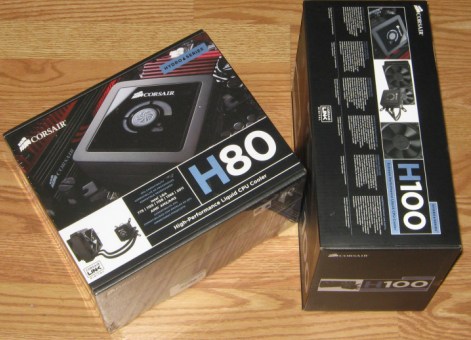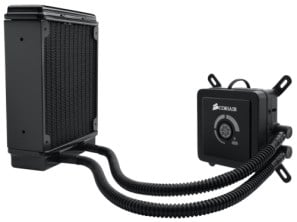Liquid Cooler Lineup: Intel, Corsair, MainGear Tested
The Contendors: Corsair's H80 & H100
Corsair currently offers an entire lineup of liquid coolers ranging from the $59 H40 (aluminum heat plate, single fan) to the H80 ($93) and H100 ($115) we're reviewing today. Both the H80 and H100 are based on CoolIT System's ECO II ALC (Advanced Liquid Cooler). Both also incorporate a three-speed fan switch, mounted on top of the pump, that allows users to set a predefined fan speed.

The primary difference between the two coolers is the size and shape of their radiators; the H80 and H100 use the same cooler plate and mounting system.
The H80 has a 120mm radiator that'll mount to any system with an appropriately sized exhaust port in the back of the case. It's designed to be used with up to two fans in a push/pull configuration and pushes between 46-92 CFM depending on fan speed.
The H100's radiator is a different animal. It's designed to mount two fans side-by-side rather than one atop the other and requires a much taller ventilation area. Unlike the H80, the H100 is meant to exhaust air out the top of the case. The upshot of this is that you'll need to make sure your case is compatible with the cooler before you buy one, and unfortunately, Corsair doesn't seem to maintain a list of compatible chassis; we used a Corsair 800D for our tests.

Corsair H80 and H100 Copper Cold Plate
The copper cooling plate attaches via four screws and supports LGA1156, LGA1366, and LGA2011 as well as all current AMD sockets. There's a pre-spread layer of thermal paste (which we used). The pump must be oriented in such a way as to ensure that the tubes have proper clearance, which typically means they should point towards either the RAM or the back of the case.
The two coolers use the same heat plate, but the fan configuration options are slightly different. The H80 supports two fans (one on each side of the radiator), while the H100 supports up to four fans in a push/pull configuration. Corsair only ships the H100 with two fans, and based on our tests, that's really all you need, but the option is there for more.
Installation and Setup:
We had no problem installing either cooler, though the LGA2011 mounting screws are a tight fit for the cooler head. Considering how much these kits cost, the included instructions are bare-boned. There's a picture guide without any sort of accompanying text and no user manual, product sheets, or included software. This last, we should note, applies to all of the liquid coolers we've seen recently with the sole exception of AMD's FX LC (not included here for obvious reasons). That kit shipped with fan controller software, while everything else is dependent on physical switches or BIOS controls.
Corsair will sell you a fan control kit...for a cool $100.











